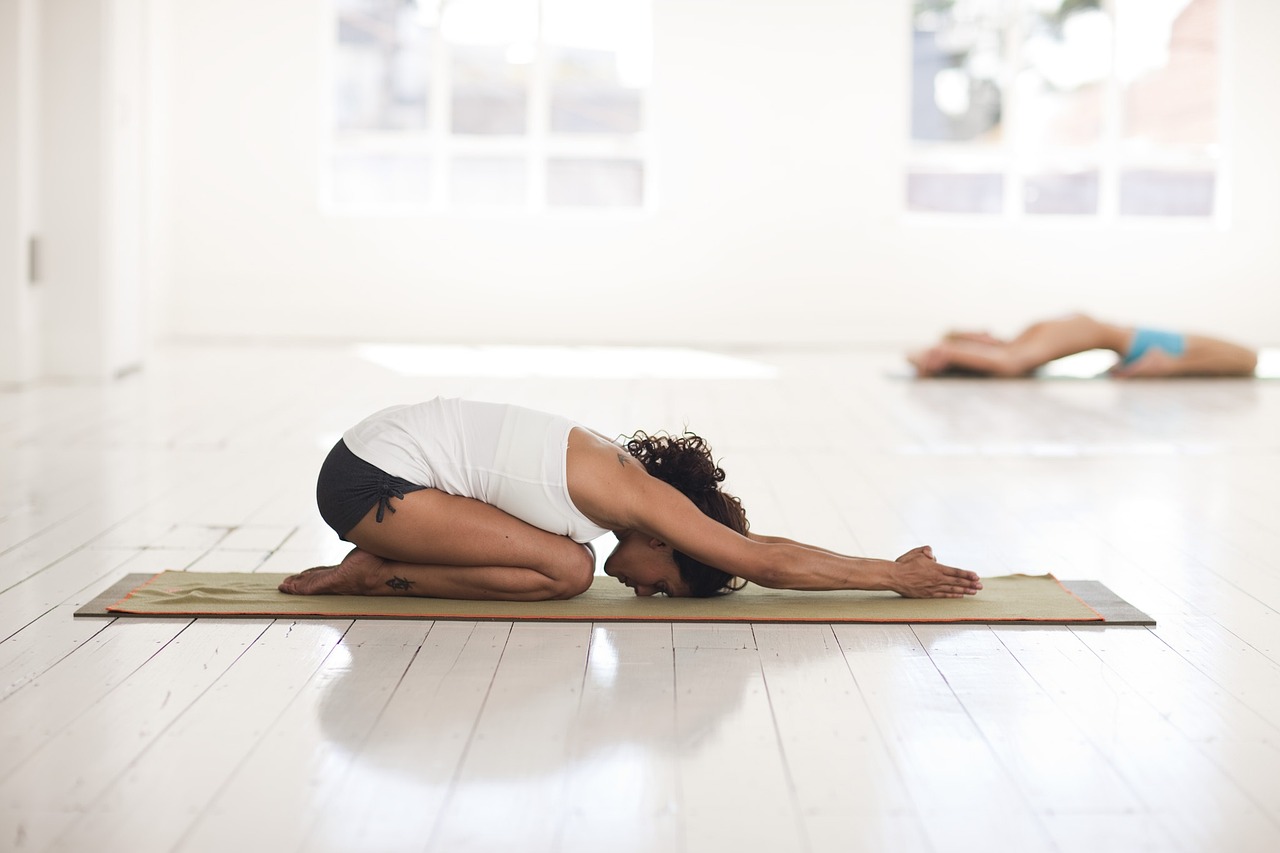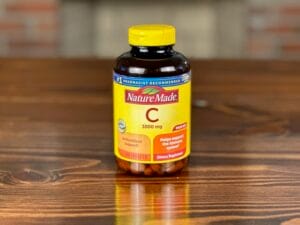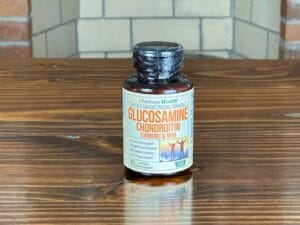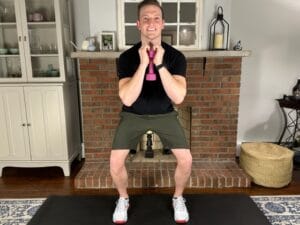Looking for physical therapist approved mobility exercises to prevent knee pain?
Knee pain is one of the most common musculoskeletal disorders that we treat in the clinic. Anyone who has experienced knee pain knows how uncomfortable and debilitating it can be. If you are already experiencing knee pain, make sure to check out our article on solutions for treating knee pain. While you can’t prevent knee pain with 100% certainty, there are a number of things you can do to truly reduce your risk of developing knee pain.
It’s possible to spend an hour every day doing a combination of strength, mobility, and flexibility exercises designed to prevent knee pain, we know life is far too busy for that type of time commitment. So we have selected a set of mobility exercises that can be completed in less than 10 minutes and you only need to do it 3 times per week to successfully reduce your chances of experiencing knee pain. This article will show you the 5 best mobility exercises to help prevent knee pain.
Disclaimers and Disclosures: All information in this article is for informational and educational purposes only and should not be taken as individual medical advice. Additionally, this article contains affiliate links, meaning when you make a purchase, we make a small commission at no additional cost to you. For more information, see our full Disclaimers and Disclosures.
Quick Guide: Best Mobility Exercises to Prevent Knee Pain
1. Quad stretch with a strap, lying on your stomach

- Stretches the quad muscle on the front of your thigh
- Hold Stretch for 10 seconds and perform 10 times
- Best Stretching Strap and Yoga Mat click the links below
2. Calf stretch standing on a slant board

- Stretches the calf muscle on the back of your lower leg
- Hold Stretch for 20 seconds and perform 5 times
- Best Slant Board click the link below
3. Hamstring stretch with a strap, lying on your back
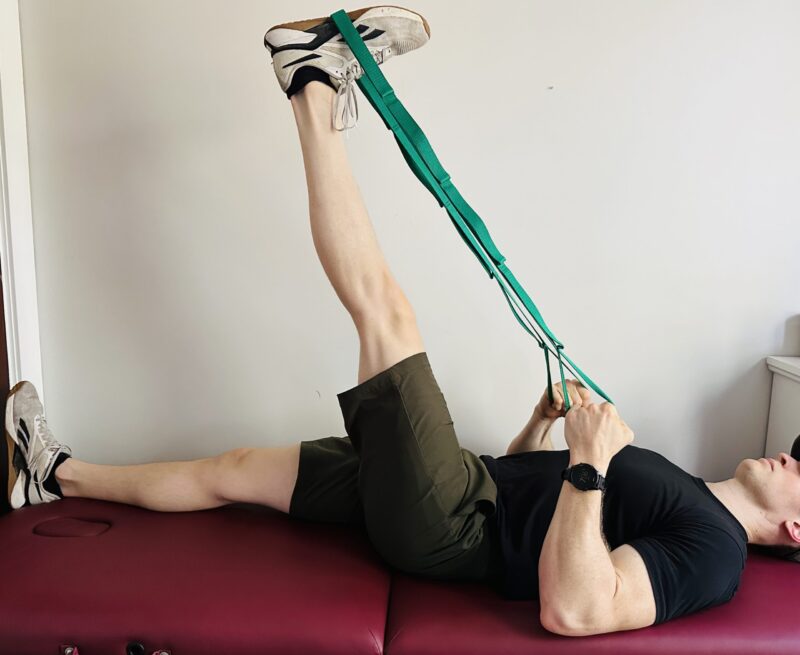
- Stretches the hamstring muscle on the back of your thigh
- Hold Stretch for 20 seconds and perform 5 times
- Best stretching strap and yoga mat click the links below
4. Foam roll your IT band, lying on your side
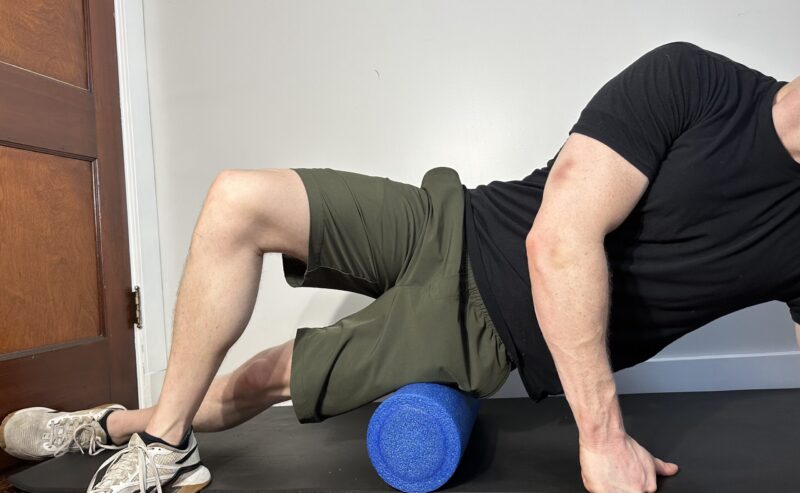
- Soft tissue mobilization to the IT band on the outside of your thigh
- Perform 30 slow passes up and down the outside of your thigh
- Best Foam Roll or Tiger Tail click the links below
5. Massage gun all of the muscles around your knee
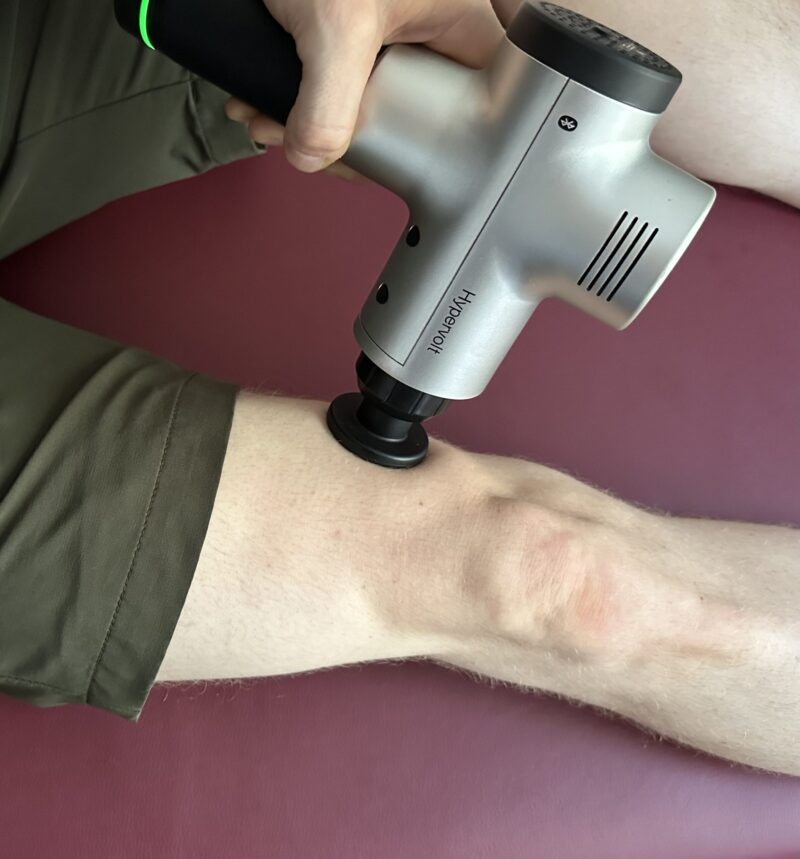
- Release all of the knots and tension in the muscles and soft tissues surrounding your knee
- Spend a total of 3 minutes working on your quad, ITB, hamstring, and/or calf muscle
- Best Massage Gun click the link below
5 Best Mobility Exercises to Prevent Knee Pain, Suggested by a Doctor of Physical Therapy
1. Quad stretch with a strap, lying on your stomach

Why stretching the quadricep muscle is important to prevent knee pain.
The quadricep muscle is the big muscle on the front of your thigh and it has the greatest impact on the health and function of the knee joint compared to any other structure. Any tightness, knots, or restricted mobility in the quad can increase the forces on the knee and lead to pain. Some of the most common disorders resulting from tight quads include patellar tendinitis, patellofemoral pain syndrome, and osteoarthritis. By making sure the quad is nice and flexible, you can make sure you are on the path to preventing knee pain.
How to properly perform the quad stretch with a strap.
Start by lying on your stomach and loop the strap around your foot. Gently pull on the strap and bend your knee until you feel a stretch on the front of your thigh. Once you feel the stretch, hold it there for 10 seconds and then relax your leg back to the start position. Perform 10 repetitions and then repeat on the other side. Do this stretch three times per week.
Professional Tip: If you need an even better stretch, roll up a thick towel or pillow and place it under your knee and then perform the stretch as described above.
What is the best equipment for performing the quad stretch?
The stretch out strap is the best alternative for several reasons. It is 6 feet long and has multiple loops and handles all along its length, so it is good for people of different sizes and allows you to get the most comfortable grip. It is also very durable and we have had thousands of patients use it in our clinic and most of them end up buying one for their own use at home.
It is also nice to have a firm but soft surface to perform this stretch on. A thick yoga mat is an easy solution to this problem, and it’s what I use at home and take on vacation with me. You can also use a massage table, which is nice if you don’t feel like getting up and down from the floor. This massage table is collapsible and portable and allows you to perform your physical therapy routines at home like our patients do in the clinic.
2. Calf stretch on a slant board

Why stretching the calf muscle is important to prevent knee pain.
The calf muscle is the big muscle on the back of your lower leg and actually crosses behind the knee joint. Many people such as runners, athletes, office workers, and sedentary individuals are prone to developing tightness in the calf muscle. This tightness can then lead to altered mechanics of the knee joint and eventually cause knee pain. By ensuring your calves are limber and long, you can reduce your chances of developing knee pain.
How to properly perform the calf stretch on a slant board.
Start by placing the slant board in front of your counter or another stable object you can hold on to. Place both feet on the slant board with your toes facing forward and your knees nice and straight. Stand tall and then gently lean your whole body forward, keeping your heels down on the board, until you feel a stretch in the back of your legs. Once you feel the stretch, hold it there for 20 seconds and then repeat 5 times. Do this stretch 3 times per week.
Professional tips: Start with just a gentle stretch at a low incline, and then as you gain mobility you can try higher inclines on the slant board.
What is the best equipment for performing the calf stretch?
Our absolute favorite piece of equipment for performing the calf stretch is the slant board, and we use this with all of our patients in the clinic and it is by far my favorite way to stretch out my own calves. You can do variations of this stretch with a foam roll, against a step, or against a wall when you are in a pinch, but none of them compare to using the slant board.
3. Hamstring stretch with a strap, lying on your back

Why stretching the hamstring muscle is important to prevent knee pain.
The hamstring muscle is the big muscle on the back of your thigh, and like the calf muscle, crosses behind the knee joint. Tight hamstring muscles are so common that the majority of our patients that come to the clinic with knee pain, hip pain, or low back pain will end up leaving with the hamstring stretch as part of their routine. Having tight hamstrings can limit the mobility of the knee joint which then leads to knee pain. By making sure your hamstrings have adequate flexibility, you can help prevent knee pain from developing.
How to properly perform the hamstring stretch with a strap.
Start by lying on your back with both legs straight and the strap around the middle of your foot. Keep your knee straight and use the strap to pull your leg straight up until you feel a stretch in the back of your leg. Once you feel the stretch, hold it for 20 seconds and then lower back down to the start position. Repeat this 5 times on each side and perform this stretch 3 times per week.
Professional tips: Many people, often desk workers or people who went through a significant growth spurt have been battling tight hamstrings for a lifetime. You will make better and quicker progress if you perform this stretch daily for the first few weeks.
What is the best equipment for performing the hamstring stretch?
The stretch out strap is the best alternative for several reasons. It is 6 feet long and has multiple loops and handles all along its length, so it is good for people of different sizes and allows you to get the most comfortable grip. It is also very durable and we have had thousands of patients use it in our clinic and most of them end up buying one for their own use at home.
It is also nice to have a firm but soft surface to perform this stretch on. A thick yoga mat is an easy solution to this problem, and it’s what I use at home and take on vacation with me. You can also use a massage table, which is nice if you don’t feel like getting up and down from the floor. This massage table is collapsible and portable and allows you to perform your physical therapy routines at home like our patients do in the clinic.
4. Foam roll your IT band, lying on your side

Why mobilizing the IT band is important to prevent knee pain.
The IT band (iliotibial band) is a connective tissue that runs along the outside of the thigh from the hip down to the knee. This whole structure can get tight, or you can develop adhesions (or knots) within the connective tissue of the IT band. Either one of these issues can disrupt the mechanics of the knee joint or cause increased friction over bony prominences. This friction over bony prominences is what can cause IT band syndrome of the knee, IT band syndrome of the hip, and hip bursitis. By performing foam rolling to your IT band on a regular basis you can help prevent these conditions from occurring.
How to properly perform foam rolling to your IT band.
Start by placing the foam roll on the ground and then lie on your side with the outside of your thigh on the foam roll. Place your other leg in front of you with your foot flat on the ground. Use your arms and other leg to slowly roll the side of your thigh up and down the foam roll from your hip to your knee. Perform 30 passes up and down the outside of your thigh and do this 3 times per week.
Professional tip: This is an advanced mobilization and can be quite uncomfortable. It may be easier and more comfortable to perform this mobilization sitting and using your hands to roll the foam roller up and down your thigh. Using a device called a Tiger Tail makes it a lot easier and more efficient when mobilizing in the sitting position, since it has handles you can grip on to.
What is the best equipment for performing the IT band foam roll?
There are many different foam rollers anymore, but we prefer this foam roller. It is nice and firm to provide a good mobilization but has just enough “give” to it to make this uncomfortable stretch just a little more tolerable. It also has a smaller diameter inner portion that is removeable, so you can target other areas of your body with it.
The Tiger Tail is our favorite piece of equipment for the sitting version of this mobilization. It has handles for a good grip and a dense foam roller portion that provides a good mobilization to all types of muscles and tissues. It is also very sturdy, so you can apply good pressure with it and mine has held up for years with no signs of wear and tear.
5. Massage gun all of the muscles and soft tissues around your knee

Why the massage gun is so helpful in preventing knee pain.
The massage gun is one of the best mobility tools because of its versatility. You can use the massage gun on your quads, hamstrings, calves, and IT band in order to mobilize these tissues and help prevent knee pain. Unlike the previous exercises that are mostly general stretches that will increase the overall length and flexibility of the target tissue, the massage gun can target smaller and very specific areas of tightness.
You can use the massage gun to search out all of the soft tissues around the knee for knots and areas of tightness or tenderness. By working these tight areas and releasing the tension, it will allow the muscles to function better and maintain good mechanics of the knee joint. An additional benefit of the massage gun is that it is a passive mobilization, which means you can relax and let it do the work for you.
How to properly perform the massage gun mobilization around your knee.
You can do this mobilization in pretty much any position that is comfortable for you. The most important thing is to stay on the soft tissues around your knee and stay away from the bony prominences of your knee. Basically, if it’s hard then stay away from it, if it’s soft you can work into it.
I like to start sitting with my leg straight but relaxed and then I’ll move the massage gun slowly up and down my quad muscle. Search out the entire quad muscle and see if you can find 2-3 areas of tightness or tension. Once you find these areas then spend 30 seconds working into each one. When you finish with the quad, then move on to the IT band, the calf, and the hamstrings. Don’t feel like you have to do every area each session though. Spend a total of 3 minutes each session and do this 3 times per week.
Professional tip: Start with the lowest setting on the massage gun and then once you have become experienced you can try the higher settings. There are also different attachments you can try, so feel free to turn this into your own freestyle and have fun with it.
What is the best massage gun to perform this mobilization?
We recommend using the Hypervolt. It is a little bit more expensive than some of the value massage guns that have come on the market recently, but the quality and dependability is worth the price. It has 3 different speed settings and multiple attachments that are helpful for working into areas all over your body. The battery is long lasting and easy to recharge. I’ve had mine for over 3 years now and it still works like the first day out of the package.
Best Mobility Exercises to Prevent Knee Pain Conclusion
These 5 mobility exercises will help you hit the ground running on your journey to preventing knee pain. Remember that consistency is one of the most important determinants of a successful outcome. So find a routine that allows you to do these exercises three times per week and I have faith that your knees will be thanking you in the future.
Why you can trust Physical Therapy Simplified for the best mobility exercises for knee pain prevention
At Physical Therapy Simplified, our mission is to provide an easily accessible and highly reputable source of physical therapy information that anyone can understand, follow, and benefit from. We want you to feel confident that you are getting the best content and information that will help to reduce your pain and restore you to your highest functional potential.
The author of this article, Andrew Harkins, DPT, has demonstrated expertise in the field of physical therapy and is certified by the American Board of Physical Therapy Specialities as an Orthopedic Clinical Specialist. He has over ten years of experience as a licensed physical therapist and is an expert in treating conditions related to the knee.
Andrew has worked as a teaching assistant at the University of Pittsburgh in their Doctor of Physical Therapy Program. Specifically, due to his expertise in treating knee conditions, he assisted in musculoskeletal coursework and provided instruction on dysfunctions of the knee joint.
